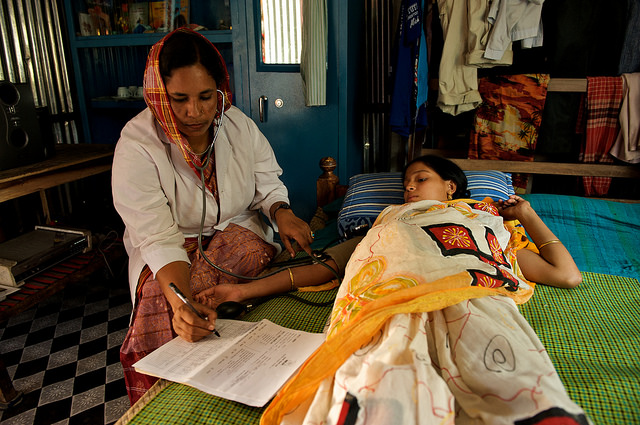What does it take to make motherhood safe?
Reading Time: 3 minutes
Making motherhood safe in Bangladesh is an achievable goal, but we have a long way to go before safe motherhood is a reality for all. The most fatal complications are easily preventable, and with quality care and facilities, we are striving to get there.
It has been three hours, but the baby is stuck. The women push and pull, but they do not know what is wrong. It is an obstetric complication called shoulder dystocia; whereby the baby’s shoulder gets stuck after the head has passed through the birth canal.
Occurring in 0.3-1% of births, it is both rare and possibly fatal.
The women, relatives of the mother, Roksana, persevere. They are not trained midwives or obstetric nurses, and have no idea how to manage the situation. The thought of taking the mother to a hospital or health facility does not occur to them. Home delivery is the only tradition they know.
It is estimated that over 60% of Bangladeshi women prefer giving birth at home. The majority of these births (58%) are attended by relatives or unskilled traditional birth attendants. This is a drastic improvement, considering the figure was at 90% just a decade ago.
60% it is still too high; women in delivery are in grave danger when complications arise.

Our community health worker performs a check-up on a young pregnant mother.
A number of factors influence home births- traditional views influenced by culture and religion, distance from health facilities, lack of transport options and poor road conditions. There is also limited decision-making by women of the households, with families often discouraged by the cost of giving birth.
Stigma also plays a role. 20-year-old Selina is a client of one of BRAC’s maternity centres (BMC).
“Growing up, I saw women die in prolonged labour,” she says, “I saw babies die. My mother, mother-in-law and husband all supported my decision to give birth at the maternity centre. But when relatives found out, they said it was shameful.”
—
Another hour passes. The mother is weakening. A knock on the door.
The local shasthya kormi, (community health worker) here to check up on Roksana. As part of her job, she identifies pregnant women in the community, and encourages them to utilise BRAC’s services. She has visited Roksana regularly over the past nine months, giving her antenatal checkups, and expected Roksana to give birth at BRAC’s maternity centre – a five-minute walk away.
Acting quickly, she instructs the women to carry Roksana to the maternity centre. Rickshaws and tuk-tuk cannot pass through the narrow alleys of the urban slum.
There is no time to get her to a referral hospital, the standard procedure for birth complications. But there is a midwife trained in obstetric emergency care on duty at the centre. Miraculously, the baby and mother survive.
Unfortunately, over 10,000 women die every year in Bangladesh from childbirth related causes, often bleeding out from post-partum haemorrhage.
20,000 women develop obstetric fistulas- a small hole in the urinary tract or rectum causing uncontrollable leaking of urine and faeces, resulting from pushing forcefully for hours, or even days. The baby often dies in the womb.
The mothers, often teenagers, are ostracised by their husbands, and suffer their whole lives unless they get surgery. Only a few do, even though the majority of these women could be saved if they have access to quality, but basic care.
Our maternity centres are fully staffed by midwives, with a doctor present once a week. The setup is simple- a delivery room stocked with essential medicines and equipment, and a labour room. Almost 18,000 babies were safely delivered at BRAC’s maternity centres across the country in the past year.
In the past decade, BRAC’s Manoshi programme, operating in urban slums, has increased the proportion of women having four or more antenatal care visits from 27% to 52%, and increased facility based deliveries from 15% to 65%. Each of BRAC’s birthing centres serves nearly 2,000 households in these urban slums.
But safe motherhood extends far beyond safe labour and delivery. Manoshi also provides post-natal care, educates women about nutrition, sanitation, family planning services, and prevention of mother-to-child transmission of HIV/AIDS.
Over 50% of women in Bangladesh suffer from malnutrition, making nutritional education a key focus. Nutritional deficiencies such as Vitamin D, B12, iron and folate have been linked to higher maternal and infant mortality. Globally, anaemia contributes to 20% of maternal mortality, as it is linked to increased blood loss during delivery, and puts women at greater risk of postpartum haemorrhage.
Yet it is easily preventable. BRAC’s community health workers test haemoglobin levels to detect anaemia, and provide iron supplements and micronutrient powders to supplement meals. Women are also advised what type of food to eat, and in what quantity.
Making motherhood safe in Bangladesh is an achievable goal, although the country has a long way to go before safe motherhood is a reality for all. But birth by birth, we are striving to get there.
Bibi-Aisha Wadvalla is a communications manager of BRAC’s health, nutrition and population programme.





